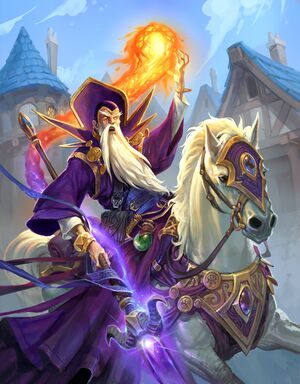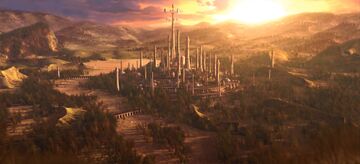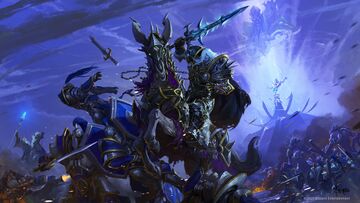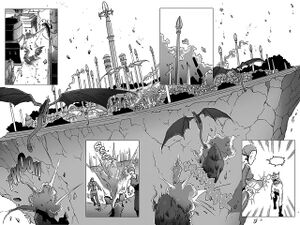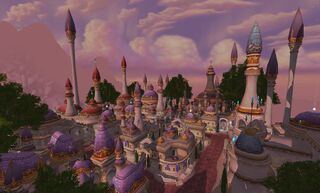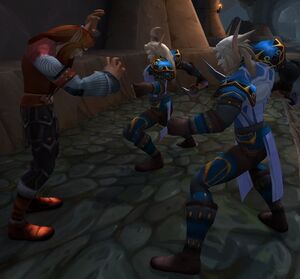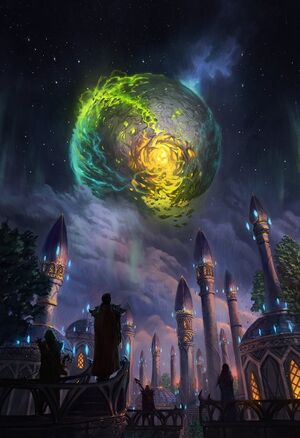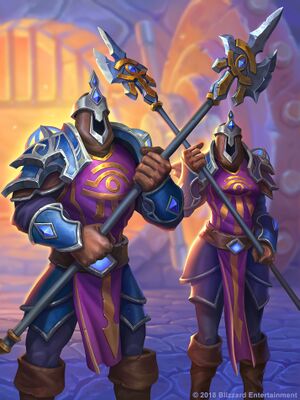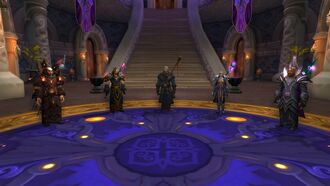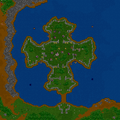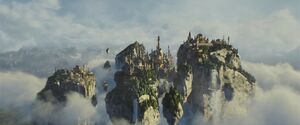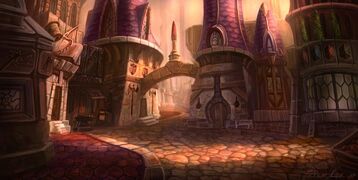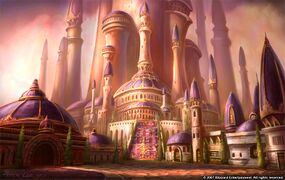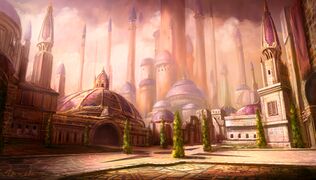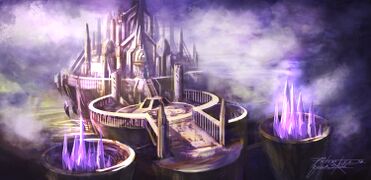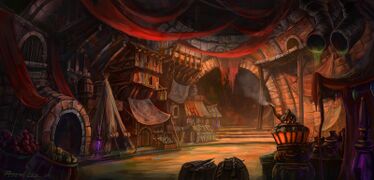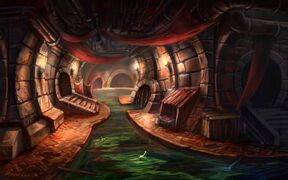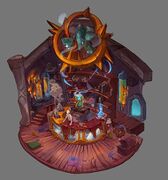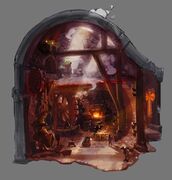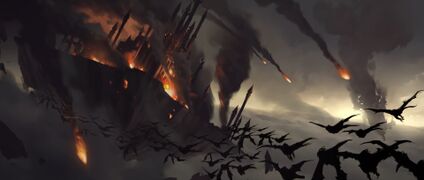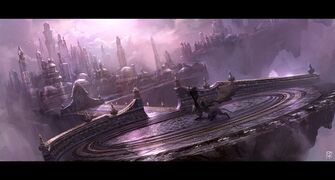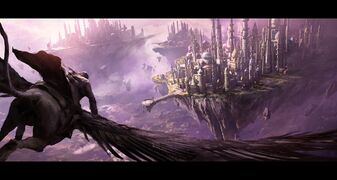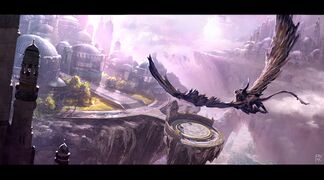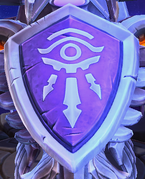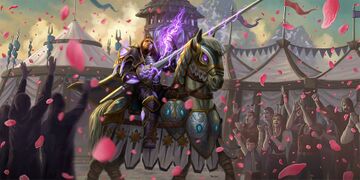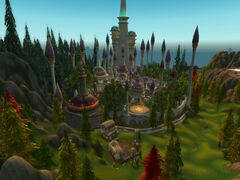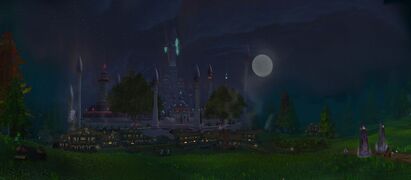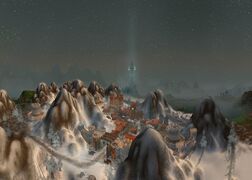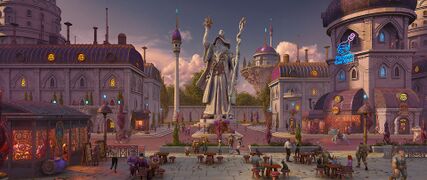Dalaran (kingdom)
- This article is about the lore of the nation and city of Dalaran. For the original territory in Lordaeron, see Dalaran Crater. For the city in-game and everything gameplay related, see Dalaran.
 | |
| Main leader | |
| Formerly | See below |
| Race(s) |
|
| Capital | Dalaran City |
| Other major settlements | See below |
| Government | Magocracy[2] |
| Language(s) | Common, Thalassian, Various languages |
| Sub-group(s) | Dalaran's factions |
| Affiliation | Independent[3] |
| Formerly | Alliance,[4][5] Alliance of Lordaeron, Arathorian Empire |
| Status | Active |
| Reputation | |
| Tabard |
 |
“Citizens of Dalaran! Raise your eyes to the skies and observe! Today our world's destruction has been averted in defiance of our very makers! Algalon the Observer, herald of the titans, has been defeated by our brave comrades in the depths of the titan city of Ulduar. Algalon was sent here to judge the fate of our world. He found a planet whose races had deviated from the titans' blueprints. A planet where not everything had gone according to plan. Cold logic deemed our world not worth saving. Cold logic, however, does not account for the power of free will. It's up to each of us to prove this is a world worth saving. That our lives... our lives are worth living.”
Dalaran, officially the Magocracy of Dalaran,[7] is one of the seven human nations in the Eastern Kingdoms. It is a small, magocratic nation originally founded as a city-state by magi of the Arathorian Empire. It is ruled by the Kirin Tor, an elite cadre of the most powerful wizards in the known world, under the leadership of the Council of Six. Originally located near the southern coast of Lordamere Lake in Lordaeron, its capital, also called Dalaran, was magically lifted and moved to Northrend during the war against the Lich King, until it was teleported to the Broken Isles during the third invasion of the Burning Legion.
For over two thousand years, Dalaran maintained a friendship with the elven kingdom of Quel'Thalas.[8] However, this alliance would be strained by their differing loyalties, and was broken as a result of the Purge of Dalaran.[9] During the Second War, the mage-state was a strong supporter of the Alliance of Lordaeron and devoted their knowledge as well as the power of their awesome magiks against the Old Horde. By the time of the Third War, Dalaran was home to many of the greatest sorcerers of the time,[10] while most contemporary human and high elven mages bowed to the sovereignty of the Kirin Tor.[11] However, the Siege of Dalaran by the Scourge forced the Dalaranian people to flee their kingdom, while the Kirin Tor's leadership and its surviving members were scattered after Archimonde destroyed the city.
In the aftermath of the Third War, the survivors returned to rebuild the ruins of Dalaran and created a vast, magical dome around the heart of their city. After Dalaran was restored to its former glory, the Kirin Tor magically floated the city so that no ground assault by the undead could ever reach them again.[12] The nation has since become one of the foremost forces standing against the threats posed to Azeroth's survival, with Dalaran serving as a neutral ground where the heroes of every kingdom could join together against their mutual foe; a place where all were welcome, so long as they behaved themselves.[3]
The city of Dalaran has the greatest concentration of magic in the world, other than the lands of Quel'Thalas, and is defended by some of the most powerful magi in Azeroth.[13]
History
Early history
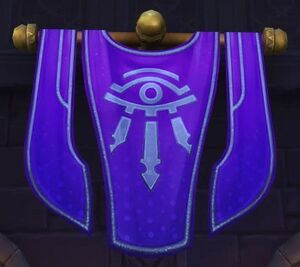
2,700 years BDP, following the Troll Wars, the humans of Arathor expanded their empire in size and power. After the death of King Thoradin, the empire founded new city-states in the wilderness - including Dalaran. Established in the heart of the empire, Dalaran quickly became a trading center of great import and influence, while citizens from across Arathor flocked to the city in a quest for wealth and new opportunities. Long ago, most human magicians lived in Strom but eventually left the restraining confines of Strom behind and traveled to Dalaran, where they hoped to use their new powers with greater freedom, wanting a place more suited to extensive use and study of magic. Among the many immigrants who moved to the burgeoning trading outpost, Ardogan was a brilliant and eccentric mage who won the admiration of Dalaran's inhabitants and was elected its ruler. Under his leadership, Dalaran continued to expand in power until it evolved into an autonomous city-state.
At this time, many of Arathor's magi were subject to suspicion and prejudice by the general population, and Ardogan declared that Dalaran would be a haven where these magi could live free of prejudice. Many sorcerers answered his call, and when the first group of these sorcerers arrived, they decided to remake the city into a glorious center of knowledge; a city of magic and learning. Using their great powers, the magi expanded Dalaran in size and scope, building up the enchanted spires of the city.[14] They raised gleaming spires throughout the city and constructed vast libraries and repositories of arcane wonders. In time, Ardogan and the most powerful of the newcomers formed a magocracy to govern the city, and this ruling body encouraged the study and practice of arcane arts. Within a few years, Dalaran exploded in population, and though only a small percentage of residents could wield the arcane, the protection they offered allowed trade and industry to grow unimpeded. Crime was virtually nonexistent, the dangers of the wild were largely forgotten, and Dalaran became a decadent, extravagant paradise.[15]
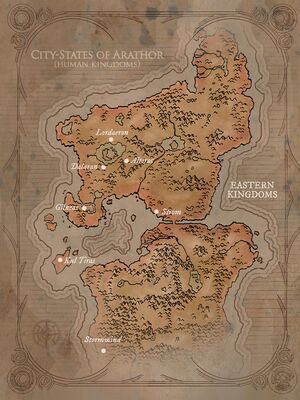
In time, Dalaran established a friendship with Silvermoon, which while tested, would stand for over two thousand years to come.[8][9] Although predominantly a human city, some elves, including the crown prince Kael'thas Sunstrider of the kingdom of Quel'Thalas, would study, live, and even rule in Dalaran at one point or another. According to Jaina Proudmoore, some of these elves were among those who had taught humans magic to begin with.[16] Some gnomes, dwarves, and even goblins would also come to reside in Dalaran. Over time the power of Dalaran and the other city-states grew as that of Strom waned, eventually they developed their own customs and beliefs. Its once-small trading outposts and cities had grown into independent city-states, which over generations became increasingly distant and insular, now only concerned with their own well-being.
Yet, as their numbers and influence grew with more and more magi practiced their arts, the fabric of reality around Dalaran began to weaken and tear. The wizards' overuse of magic with no proper protection or regulation acted as a beacon for the Burning Legion, luring them back to Azeroth. Demons slipped through the gaps in reality, terrorizing the locals until the ruling Magocrats were forced to turn to the elves for aid. The Convocation of Silvermoon sent high elven wizards who quickly realized what had happened. Though not a prominent thread, they warned that the problem would grow worse unless the magocracy placed limits on humans' use of magic. The Magocrats refused, since the magi had come to the city to freely practice their arcane arts. Restricting them would result in a number of detrimental effects. At best, most of the brightest magi would leave and continue their arcane studies elsewhere. At worst, Dalaran's entire economy would collapse, sparking a revolt and scattering the magi to the far corners of the land. One way or another, the use of arcane magic would continue, be it within Dalaran's walls or without, and no matter what happened, the threat posed by the Burning Legion would always exist. Instead, they proposed selecting a group of powerful magic casters to protect them from the Legion. Together, they formed the Council of Tirisfal, which would form a secret defense for the world with a Spearhead[17] as their main acting weapon. The order's gifted members would be responsible for tracking and banishing the Legion's agents wherever they might be found across the land, and would also quietly educate other magi about the dangers of reckless spell-weaving. While the elven lords revealed the history of ancient Kalimdor and the Legion, the Magocrats sent some of their numbers to research and catalog all human magic. These wizards would eventually become the Kirin Tor, a specialized organization that was charged with cataloging and researching every spell, artifact, and magic item known.[18] The Council of Six became the rulers of the Kirin Tor, and eventually replaced the Magocrats at the head of Dalaran.[19]
Under the vigilant watch of the Order, Dalaran became the chief center of learning for magicians throughout the land.[20][17] Dalaran, though not a large city, was a beautiful place of towering spires and glittering streets, and the people there were happy and well protected. The Kirin Tor's headquarters was the Violet Citadel, an impressive building so named for its stone walls which gave off a faint violet light. The building had many libraries, research chambers, testing rooms, classrooms, meeting alcoves, and bedrooms.[17][21] At some point, the half-elf Alodi was abandoned in Dalaran, where he was raised in the orphanage and later became a student of the Kirin Tor.[22]
Following the War of the Ancients, the blue dragonflight's clutch was taken care for by the other dragonflights in Malygos' absence. This new generation of young blue dragons initially hid their true identities behind mortal visages and sought membership within the Kirin Tor to offer their support, and to ensure that the elite mages of Azeroth did not misuse magic again.[23] As such, Dalaran offered refuge to mortals and dragons alike for generations.[1]
Eventually, Dalaran's prosperity made it inundated by reckless spellcasters. Their abuse of magic inadvertently tore open rifts in reality, and a nathrezim named Kathra'natir clawed his way into Azeroth through one such rift. This cunning demon spread his poison through the hearts and minds of the populace, while terrible plagues gripped Dalaran. As the affliction spread, a veil of paranoia enveloped the capital, since many of the city's non-magic users were superstitious, and they viewed spellcasters with thinly-veiled unease.[18] Kathra'natir later used Apocalypse to inflame these fears, but also tainted Dalaran's water supplies and food stores. Upon investigating these phenomena, the Council of Tirisfal confronted the demon but lost their Spearhead, Aertin Brighthand. Eventually, Meryl Winterstorm and Alodi came up with the idea of the Guardian of Tirisfal, a complex ritual that could permanently grant someone a portion of the council' power. As such, Guardian Alodi banished the dreadlord, saving Tirisfal Glades and Dalaran from destroying themselves.[24][17] For more than a millennium, the Guardians waged their secret war against the Legion, while Dalaran continued to serve as one of the world’s foremost centers of arcane knowledge and research.[25]
1,200 years BDP, the empire splintered into seven independent kingdoms.[26] Later it was found that Dalaran had been built atop a massive ley line.[27]
Before the Great Wars
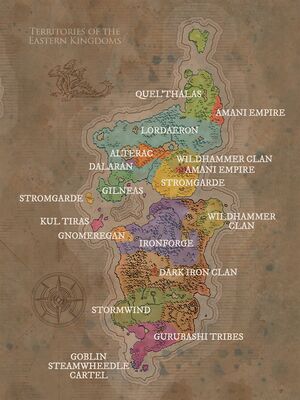
Around eight hundred years BDP, new Guardians of Tirisfal still came and went, with some retiring in peace while others fell during their tireless war against the Burning Legions agents. Nevertheless, Dalaran remained safe under the Guardian's watchful eye. At this time, Scavell had been the Guardian for several centuries, until he was succeeded by Aegwynn.[28]
Six hundred years ago, during one of Aegwynn's rare visits to Dalaran, the Council of Tirisfal ordered her to step down as Guardian. However, she told the magi that putting the fate of Azeroth in their hands was tantamount to dooming the world, as she believed that the council was abusing its power by manipulating the politics of the Seven kingdoms. If she would not give up her powers voluntarily, the Council would force her to do so. Ultimately, they formed the Tirisgarde, an order of magi considered as the elite mage-guard of Dalaran, and girded with relics and armaments that could diminish the Guardian's incredible powers.[29] After years of training, these resourceful and gifted hunters set out to find Aegwynn and bring her back to Dalaran.[30]
Approximately five hundred years prior to the opening of the Dark Portal, the black dragon Sintharia, former prime consort of Deathwing, attempted to bring down the Kirin Tor with a curse that left all the wizards in the city unable to use their magic. Her scheme was foiled in part by Korialstrasz, consort to Alexstrasza, and most believed her to be dead when her own magic had been turned on her.[31]
75 years before the First War, King Barathen Wrynn of Stormwind sent envoys to beseech Lordaeron, Dalaran, and the other human kingdoms for aid during the Gnoll War. But they would not send assistance, seeing no advantage in helping the smaller, rural nation, as Stormwind was self-sufficient and trade with the other kingdoms was rare.[32]
21 years BDP, Azeroth enjoyed a time of relative peace and Dalaran was known for having made extraordinary advances in the study of the arcane arts and other academic fields.[33]
Before the coming of the orcs, the human kingdoms of Lordaeron faced challenges and obstacles from each other as the games of politics played out.[34]
In time, the Kirin Tor mages and their leadership took an interest in the Guardian Medivh, and around the time of the First War, they sent Khadgar to Karazhan to act as his apprentice. Several mages asked Khadgar to learn various details regarding the tower or the Guardian. Among them was Guzbah, who studied demon lore and was the first victim of strange demon killings across the Eastern Kingdoms, followed by seven mages of the Violet Citadel who died in mysterious circumstances, including archmage Arrexis. Besides Guzbah all of them were secretly members of the Council of Tirisfal,[35] and the responsible was none other than Medivh, possessed by the Dark Titan Sargeras.
As the First War started, the wizards of Stormwind were first intrigued and then terrified by the orcs' appearance, and sent many letters with information and then requests for aid to Dalaran as the situation grew more dire for them. The northern mages appreciated the orcs' danger but thought them little more than a local nuisance, confined to that continent, and as such didn't do much to help.[36] In the shadow, it was Deathwing, disguised as a human noble named Daval Prestor, who spread rumors in Lordaeron that the tales of orcs were merely fabrications meant to hide growing problems with human rebels, which had seemed far more believable than Stormwind's cries for help. He also subtly influenced the minds of those who stubbornly believed the reports with his magic.[37]
Second War and aftermath
Following the fall of Stormwind to the Orcish Horde, the nation was present during the Council of Seven Nations, represented by the Archmage Antonidas.[38] After heated debates, and Turalyon's encouraging speech to unite them, Archmage Antonidas pledged the support of Dalaran with the other kingdoms to the newly formed Alliance of Lordaeron,[39] with Khadgar as their liaison.[40]
At the time of the Second War, the nation was home to the four towers, sanctum to the lands' greatest sorcerers.[41] Dalaran later sent large amounts of aid and magi to the war effort, and among them, some were the former students of the Conjurers of Azeroth who fell during the First War. Whether in their sanctum or on the many battlefields of Lordaeron, the mages were resolute in their efforts to defend the people.[42] During the conflict, some Dalaranian citizens were captured by the kingdom of Alterac[43] and the city itself was attacked by the orcs at some point,[44] and so the wizards had to focus their magics in a device known as the Eye of Dalaran in order to rebuild it to its former glory.[45] Some fallen spires were as such raised back.[46]
Though the Dark Portal was destroyed, the Kirin Tor noticed that a rift remained that connected Azeroth and Draenor together, and so they built up the Nethergarde Keep with the help of the other Alliance nations to watch over the rift.[47] In the aftermath, Dalaran lobbied for the orcs' imprisonment, as their magi wished to study the ores and their strange magics, as much for the pursuit of knowledge as for strategic purposes. The Kirin Tor argued that by better understanding the orcs’ strengths and weaknesses, they could defeat them if war ever broke out again.[48]
Following the reopening of the Dark Portal by the Horde of Draenor, Teron Gorefiend and his death knights sought to obtain the Eye of Dalaran.[49] Aided by Deathwing, the Black Aspect gathered his black dragonflight and assaulted Dalaran's outer defenses, providing them a distraction to sneak into the city. As magi rushed to defend their home from the dragons, Gorefiend and his followers crept through Dalaran's streets, and soon they successfully entered the Arcane Vault to steal the artifact. Consequently, Archmage Antonidas and a handful of magi battled the death knights in the vault, but the element of surprise was on the Horde's side and they managed to escape to Draenor.[45][50][51] When the Alliance sent an expedition to finish the Horde of Draenor once and for all, a group of Kirin Tor wizards and Dalaranian citizens led by Archmage Vargoth established a base named Kirin'Var Village on the shore of the Devouring Sea, in Farahlon. When Draenor was torn apart, the explosion devastated the land and all that remained became the Netherstorm, where the survivors of Kirin'Var Village remained for seventeen years.[52]
After the Invasion of Draenor, Deathwing was aware of the danger Dalaran represented for his disguise and hoped that he could sow distrust among the wizards and toward the other Alliance members. During the Alterac crisis, he manipulated the human kings into making him the future king of Alterac but drew the suspicious attention of the Kirin Tor who were conveniently left out of the negotiations by the black dragon.[53][54] His plans were ultimately thwarted after the Battle of Grim Batol which forced him into hiding, causing Daval Prestor to mysteriously vanish from the royal court of Lordaeron.[55]
In the following years, it came to Archmage Antonidas' attention that Kel'Thuzad, another member of the Council of Six, had begun to experiment with the arcane art of necromancy. As this threatened the safety and reputation of Dalaran, and to avoid the wrath of the people of Lordaeron, the leaders of the Kirin Tor decided to have Kel'Thuzad's properties searched, and all items tainted by dark magic confiscated to be destroyed. While Antonidas warned Kel'Thuzad that he would be stripped of his rank and holdings, exiling him from both Dalaran and Lordaeron if he did not abandon that path, Kel'Thuzad chose to leave Dalaran and swore to serve the Lich King as the leader of the Cult of the Damned.[56]
While the Alliance of Lordaeron was unaware of the death cults forming in their lands before, the departure of Quel'Thalas who stated that the humans' poor leadership had led to the burning of their forests during the Second War,[57] alongside the liberation of the internment camps by Thrall, led to the departure of the kingdoms of Gilneas and Stromgarde from the Alliance.[58] However, several kingdoms made it known that they had no intention of letting the faction collapse, among them was Dalaran.[59] Although Dalaran remained loyal to the fractured Alliance, it was noted for being politically aloof and secretive. Magi of the Kirin Tor did not get involved in "ordinary" politics, and outsiders were rarely welcome in Dalaran, even visiting royalty.[60]
During the trial of Tirion Fordring in Stratholme, Antonidas represented Dalaran as one of the four jurors. Like the other judges, he was shocked when Tirion admitted his guilt, which led the paladin to his excommunication and his exile.[7]
Third War and aftermath
“We've prepared for your coming, Arthas. My brethren and I have erected auras that will destroy any undead that pass through them. Pull your troops back, or we will be forced to unleash our full powers against you! Make your choice, death knight.”
- — Archmage Antonidas during the Siege of Dalaran.[61]
By the time of the Third War, Dalaran was the home of an incredibly large library of books and tomes, and most contemporary human and high elven mages bowed to the sovereignty of Dalaran and the Kirin Tor.[11] Tutored in the Halls of Magic at the mystical city of Dalaran, sorceresses and priests diligently study their mysterious arts within the Halls of Magic of Dalaran.[62]
When the Kirin Tor discovered a mysterious plague gripping the northlands, the Dalaranian ambassador to King Terenas Menethil II revealed that the Kirin Tor were prepared to place the villages under strict quarantine. However, the king of Lordaeron declared that there would be no quarantine without proof of these claims as its people had suffered enough.[63] When the Third War began, some of the aspiring geniuses of the magocracy were allured by the dark arts and forsook their very souls, becoming necromancers in service of the Lich King Ner'zhul, who granted them power over the dead in exchange for their obedience.[64] When Capital City fell after King Terenas was killed by his corrupted son, magi from Dalaran went to the ruined kingdom of Lordaeron along with other Alliance soldiers to deal with the rampaging undead army, but soon found themselves overwhelmed.[65]
Under the direction of Archimonde, the Scourge led by the death knight Arthas prepared to invade Dalaran to claim the Book of Medivh. The idea of using this artifact to open the way for the Burning Legion came from the Lich King, as he knew that it would be possible to access it with the help of the now-resurrected lich Kel'Thuzad, who had been one of Dalaran's rulers.[66]
With the Scourge approaching Dalaran, the Kirin Tor evacuated most of the city's civilians, leaving behind only a small resistance force. Though these defenders were few, they were some of the greatest magi in the world. Not only that, as Dalaran itself was a weapon whose magic coursed through the streets, arcane barriers blanketed the city and many of these wards would destroy any undead that touched them.[13] As the Kirin Tor’s leader, Archmage Antonidas could not abandon Dalaran, since protecting the city and its vaults of arcana was his duty. Nevertheless, he managed to convince his apprentice, Lady Jaina Proudmoore, to save as many innocents as possible, as both knew that the city could not hold out against the Scourge. In the days to come, Jaina worked tirelessly to rally as many refugees as she could. When she set sail for Kalimdor, her forces included members from nearly every Alliance race, including people from Dalaran and other human nations in the region.[67]
On the day of the Siege of Dalaran, the Scourge met resistance every bit as formidable as that of Lordaeron or Quel'Thalas. The Kirin Tor's magi battered the undead with a barrage of arcane energy, wreaking havoc on the invaders, while the arcanic defenses and the magical guilds in the city tried to defend it. However, this frontal assault was nothing more than a diversion for Arthas, Kel'Thuzad and the dreadlord Tichondrius who killed the wizards maintaining the auras and arcane barriers on the capital, and confronted Archmage Antonidas who fought until his last breath.[68] Although the forces of Dalaran fought on even after Antonidas' death, the undead and demonic reinforcements were able to hold them long enough.[69] Using the Book of Medivh,[61] Kel'Thuzad summoned Archimonde who immediately turned his ire on Dalaran, considering that if left alone, the magi would remain a constant thorn in the Legions side. He gathered the latent energies permeating Dalaran and single-handedly laid waste to the city by creating a magical effigy out of the dust, which he then crushed; the mighty towers of Dalaran fell simultaneously.[70]
In the aftermath, many people died trapped under the rubble of the fallen city, unable to be reached in time by their comrades.[46] At the same time, the city's remnants went to chaos, with mutants, experimental rejects, renegade wizards and berserk water elementals roaming the streets.[71] The destruction of Dalaran was a massive blow to the Kirin Tor, leaving its surviving members scattered and its leadership in disarray, while the burning of the great libraries caused the loss of countless generations of knowledge.[72] The remaining members of the organization were known to have partial control of the city,[73] and at an unknown time, some of their magi were known to have been killed by the pets of Hakkar the Houndmaster.[74]
Soon after the defeat of the Burning Legion at the Battle of Mount Hyjal, parts of the city (with its tunnels and dungeons) were still contested by the Scourge and later by Illidan Stormrage's naga forces sent to scout the area.[75][76][77] When Prince Kael'thas Sunstrider and his forces approached the ruins of Dalaran, Illidan had already began his spellwork to destroy the Frozen Throne on the orders of Kil'jaeden, drawing on Dalaran's ley lines to amplify the Eye of Sargeras's destructive potential. The Lich King's only recourse was to unleash the Scourge on Dalaran to stop the spellwork, but they were too late. Illidan unleashed the tempest of arcane energy towards the Icecrown Glacier, and the influx of magic caused the land itself to buckle, with massive fissures erupting near Dalaran and across the world. Though his spell was eventually interrupted by the night elves, Illidan discovered a tear in the fabric of reality near Dalaran (where Kel'Thuzad summoned Archimonde) and used it to weave a portal to Outland, while Lady Vashj and her surviving naga managed to flee and take shelter deep within nearby Lordamere Lake.[78]
After Illidan's departure to Outland, the Dalaranian survivors began to rebuild the ruined city which was taken over by Grand Marshal Garithos and the Alliance Remnants, soon joined by Prince Kael'thas and his brethren. Before long, the Scourge launched a counterattack to take Dalaran and the battle would be one of the largest waged in Lordaeron since the kingdom's fall. As the Scourge advanced, Garithos dispatched the blood elves and commanded them to stop one of the undead armies before they could reach Dalaran. However, victory was impossible, and Kael'thas had little choice other than to accept the help of Lady Vashj and her naga. When Garithos learned what had happened, he condemned Kael'thas for treason and locked the blood elves within Dalaran's dungeons to await execution.[79] With the help of Lady Vashj, the blood elves managed to escape to Outland, leaving Dalaran behind them.[80] While elves such as Aethas Sunreaver would later vouch for the Kirin Tor's innocence in these events, others like Rommath would accuse them of looking the other way. What power the Kirin Tor had in Dalaran around this period remains vague, although Modera and Ansirem Runeweaver were believed to have been present.[9]
Following the blood elves' escape, the remaining human refugees and paladins still surviving in Tirisfal Glades started retreating to Dalaran. Many of them were intercepted by the Scourge and slain.[81]
World of Warcraft
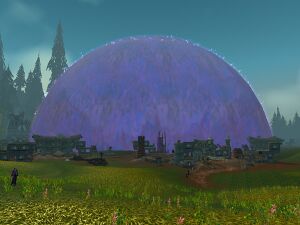
In the years following the Third War, the surviving wizards of Dalaran returned to the ruins and constructed a vast, magical dome around the heart of their city. Some believe it was for protection from the violence of these times, others say they merely wanted solitude, to study and plot. The shield was opaque and completely impenetrable by any known means warding off any new attack while the magi slowly regained their strength. In time, Archmage Rhonin was chosen to lead the Kirin Tor and led the reconstruction of Dalaran and its defenses.[21][82][83] The area and ruined outskirts of their city were patrolled by the wizards and their earth elemental minions.[84] At some point, Jaina Proudmoore returned to the city and designed the Antonidas Memorial statue.[85]
While a conflict occurred between the Alliance and the Forsaken in Hillsbrad Foothills, Dalaran had its forces stationed in Ambermill, Nethergarde Keep, the Lordamere Internment Camp and parts of Silverpine Forest. At first, the Kirin Tor was not knowledgeable about the Forsaken, believing them to be just another clan of undead,[86] until they eventually came into conflict over Ambermill. The thieves of the Bloodstone Artifacts led by Kegan Darkmar were later granted asylum from the Forsaken, and the relics were quarantined in the Lordamere Internment Camp by the wizards.[87]
According to Shadow Priest Allister, Ambermill remained a source of human opposition in the Silverpine Forest, mainly through the support they received from the wizards of Dalaran.[88] The village was located atop a dormant ley line energy node,[89] and the Kirin Tor attempted to reactivate the node for a large-scale project that was interrupted by the Forsaken, as they feared to lose their hold on the region if that had been accomplished.[90] The Deathstalkers later learned from one of their prisoners that the wizards at Ambermill have stored away important documents pertaining to the current state of Dalaran, and Mennet Carkad asked an adventuring rogue of the Horde to steal these documents.[91]
In the Blasted Lands, the mages of Dalaran kept Nethergarde Keep in operation,[92] and focused their efforts on studying the Dark Portal's effects on the region and its wildlife.[93]
At some point, seven members of the Dark Riders managed to pass the magical dome protecting Dalaran during its reconstruction and stole several powerful artifacts from the Kirin Tor's vaults. After the city's scryers discovered their identity, a Dalaran Agent of the Violet Eye traveled to Ariden's Camp in Deadwind Pass, where she tasked adventurers to bring her any of the stolen artifacts they could find, as any one of them would have been a serious danger to Azeroth in the wrong hands.[94] When the adventurers brought her the artifacts, which they obtained by facing the Riders across the Eastern Kingdoms, she announced that she would bring them safely back to Dalaran.[95]
The Burning Crusade
Prior to the invasion of Outland, Prince Kael'thas Sunstrider discovered Kirin'Var Village in the Netherstorm. One night, he led the Sunfury to attack the village with a mana bomb,[96][97][98] and was followed by Master Daellis Dawnstrike leading thousands of blood elves against the wizards.[99] Overwhelmed, Archmage Vargoth cast a protective ward on the Violet Tower to protect the survivors, however, his apprentice Naberius betrayed him and handed the blood elves the secrets of the tower's defenses. His treason caused the defeat of Kirin'var, the massacre of all civilians, and the imprisonment of Vargoth in the tower by the prince of Quel'Thalas.[100][101] After the Alliance and Horde forces arrived in Outland, Ravandwyr, an apprentice of Vargoth, asked the adventurers to help him free his master.[102] In the ruins, the ghost of Custodian Dieworth tasked the heroes to destroy the lich Naberius, as the latter prevented the Dalaranian spirits from resting in peace.[103]
Relocation
Shortly before the war against the Lich King, the red dragon Korialstrasz decimated a large Scourge army heading towards Dalaran.[104]
After Malygos deemed the lesser races' use of magic unacceptable, he proceeded to declare war on all magic users, particularly the Kirin Tor of Dalaran. When the Aspect of Magic began to realign the ley lines and the arcane energy to the Nexus in Coldarra,[105] the magi of Azeroth quickly noticed that something was amiss. After a delegation of a few powerful magi was sent out to investigate at the Nexus, Archmage Rhonin and the ranking members of the Kirin Tor were shocked to learn that some of their own had defected to the blue dragonflight's cause. The danger posed by Malygos and the Scourge was so great that the magi of Dalaran did something unprecedented: they pooled their power and teleported their entire city to the skies above Crystalsong Forest in Northrend,[106] leaving only a crater in its place. Seeing the crater left behind, the red dragon Korialstrasz had been forced to admit that it was one of the most astounding, if potentially catastrophic, spells ever cast.[107]
Shortly after after Dalaran, before the Alliance and Horde forces arrived in Dalaran, the city was attacked by Malygos and his blue dragonflight who laid open siege to the floating city. Consequently, the Archmages Rhonin, Modera and Aethas Sunreaver combined their efforts to hold off the assault, magically creating a massive shield around the city. Despite the initially unfavorable odds and the treason of Crevan, a mage hunter who released the Violet Hold's prisoners to distract the other mages long enough for Dalaran to crash, the Kirin Tor eventually drove away Malygos and his flight.[21]
Though traditionally barred from Dalaran, the Horde was accepted into the city through the efforts of Archmage Aethas Sunreaver, who sought the aid of his people back in Quel'Thalas on behalf of the Kirin Tor.[9] With this decision, the Kirin Tor proclaimed themselves neutral in the conflict between the Horde and the Alliance, seeking to help bridge the gaps between the two factions, while Dalaran became a neutral city and a place where all were welcome, so long as they behaved themselves.[3]
Consequently, the elven population underwent something of a split: the portion of the elves who converted to the blood elven philosophy took up the name of the Sunreavers, named after their leader Aethas Sunreaver. Conversely, some high elven members opposed the notion of allowing the sin'dorei back into the Kirin Tor's ranks and formed the Silver Covenant to oppose it. Its leader, Vereesa Windrunner, however, held no political sway within the city, thus leading to the blood elves officially being readmitted as members of the Kirin Tor.[108] Consequently, as a base of operations, the Alliance was given the Silver Enclave which was the base of the Silver Covenant. For the Horde, they were given the base of the blood elven Sunreavers, the Sunreaver's Sanctuary.
Wrath of the Lich King
During the Scourgewar, Dalaran served as a base of operations for many actions taken against the Lich King, while the Kirin Tor engaged the Nexus War to stop Malygos's madness.
In a sudden, other violent assault, Malygos unleashed his blue dragonflight upon Dalaran, hungry to reclaim arcane dominance over Azeroth. Using a massive crack in the Violet Hold's roof, his agents entered the prison and tested its integrity, risking the safety of everyone outside its walls. Overwhelmed, the Kirin Tor called upon heroes of both factions for assistance against the inmates escaping from their cells.[109] When the adventurers contained the danger, the rest of the prisoners that had broken free were imprisoned once more.[110] After these events, Lieutenant Sinclari tried to convince the higher-ups that maintaining an ultra maximum-security prison in the city was a bad idea, but apparently her concerns were not addressed.[111]
In time, the Kirin Tor called upon the Alliance and the Horde to fight against the mad Aspect of Magic. They later received help Queen Alexstrasza and her red dragonflight,[112] followed by representatives of the other dragonflights who had also grown wary of Malygos, leading them to form a draconic alliance known as the Wyrmrest Accord. The allied forces attempted to convince Malygos to end his destructive crusade, but their efforts were met with open hostility. They later assaulted the Nexus and Malygos was ultimately killed before his vengeance could be fulfilled.[113][114]
When Brann Bronzebeard escaped from Ulduar, he immediately notified Archmage Rhonin that a "living nightmare" was stirring within the forgotten stronghold. The leader of the Kirin Tor notified the Alliance and the Horde, hoping they would see fit to set aside their differences again, but it was a failure because of the recently disastrous battle of Angrathar the Wrathgate.[115] Consequently, the Explorers' League and the Kirin Tor later contacted members of both factions to join them in the final assault on Ulduar. The assault was difficult, but they managed to reach Yogg-Saron's prison chamber and defeat the Old God.[116]
After the adventurers defeated Algalon the Observer within Ulduar, the constellar advised them to transmit Reply-Code Alpha to the Pantheon from somewhere close to the sky, in order to prevent Azeroth's re-origination.[117] Brann believed that Dalaran was the perfect spot to transmit the signal. They met up with Rhonin who transmitted the signal into the skies from the Eventide, while holding a speech for the citizens of Dalaran to celebrate their victory.[118]
Following the fall of the Lich King, a memorial named the Dedication of Honor was erected in Runeweaver Square at the center of Dalaran, to honor the heroes who fell to the Scourge during the war in the frozen wastes. Meanwhile, the Sunreavers' goal was a success and the blood elves were officially readmitted into the Kirin Tor's ranks, as their good work fighting the Lich King earned them that return.[119]
Interlude
During the War Against the Nightmare, Malfurion Stormrage entered Dalaran to find anyone capable of fighting against the Emerald Nightmare and the Nightmare Lord in the Emerald Dream. However, the magically illuminated streets of the flying city revealed nothing but emptiness shrouded in mist, and he found most of the citizens and mages, including Rhonin and Vereesa Windrunner, trapped in their nightmares. Only Archmage Modera and her remaining comrades were holding against the shadowy attackers despite their exhaustion, so they did not join him in the dreamform army.[120]
The nation was invited by the Alliance leaders to send a representative to their diplomatic meeting in Darnassus, though declined to do so, citing its desire to retain its neutrality and continue to help bridge the gaps between the Alliance and the Horde.[121]
At some point, Archmage Ataeric and his magi of Ambermill abandoned their affiliation with Dalaran and shifted their entire town into a pocket dimension, where they plotted to return and aid the Alliance in its invasion of Lordaeron when more reinforcements arrived.[122] On behalf of Sylvanas Windrunner during the invasion of Gilneas,[123] the Horde adventurer entered the pocket dimension and killed Ataeric, returning the town to Azeroth and leaving it open for the Forsaken to invade.[124] After being resurrected, Ataeric and the Ambermill residents could be seen fighting on the Forsaken's side during the final battle for Silverpine.
Between the Cataclysm and the discovery of Pandaria, Dalaran remained in Northrend.[125]
Tides of War
After a desperate Kalecgos went to Dalaran for aid in seeking the stolen Focusing Iris, Archmage Rhonin sent him to Jaina Proudmoore in the hopes that she might be able to aid him in his search. However, as they learned of Garrosh Hellscream's ambitions to conquer the whole of Kalimdor, starting with a brutal attack on Theramore Isle, Jaina herself visited Dalaran on Kalecgos's advice, requesting for assistance in staving off the impending Horde invasion. Despite Rhonin's initial reluctance to involve the neutral Kirin Tor into a conflict between the Alliance and the Horde, the Council of Six ultimately agreed to provide limited assistance to Jaina in the defense of Theramore. Among them, Aethas Sunreaver cast the decisive vote in support of Theramore, reasoning that to do nothing would be to implicitly support the Horde's expansionism.
During the attack, Rhonin sacrificed himself in an attempt to localize Garrosh's mana bomb detonation, teleporting Jaina and a few wounded defenders to safety. When it was discovered that a Sunreaver agent was a part of the Horde's attack on the city, Aethas denied responsibility and vowed to atone for Thalen's treachery.[126] In the aftermath, the Council of Six refused to launch an attack on Orgrimmar in retaliation for Theramore's decimation, but chose Jaina as Rhonin's replacement at the head of Dalaran and the Kirin Tor. Soon afterward, many, if not nearly every member of the Kirin Tor, attended Rhonin's funeral ceremony, which concluded when the mages and denizens sent small arcane orbs floating upwards.[127]
The Blue Aspect Kalecgos later joined the Kirin Tor and stayed in the city for a time, but since he saw distrust from the other magi, he often found excuses to be away.[128]
Mists of Pandaria
At the time of the discovery of Pandaria, King Varian Wrynn sent Prince Anduin and the Alliance adventurer to negotiate with Jaina Proudmoore the withdrawal of blood elves from Dalaran, as the Sunreavers claimed fealty to the Horde and represented a major threat to the war effort.[129] Lady Jaina refused in order to maintain Dalaran's neutrality, as she wished for Dalaran to serve as a beacon of hope for peace. By showing the world that both factions could trust each other and work together in the magical city, she believed that they could eventually be above the war.[130]
However, Jaina soon discovered that the Sunreavers helped Garrosh to steal the Divine Bell, using Dalaran portals to infiltrate Darnassus,[131][132] which led to the conception of the mana bomb that destroyed Theramore Isle. Consequently, she mobilized the Kirin Tor, Alliance forces, and the Silver Covenant to purge the Horde from Dalaran.[133] Though Aethas Sunreaver claimed he knew nothing of Garrosh's scheme, Jaina incarcerated him and his Sunreavers after he refused to order his people to leave the city peacefully. Those that surrendered were imprisoned in the Violet Hold,[134] while those that resisted were put to the sword.[135] Meanwhile, Grand Magister Rommath, who had feared this would happen,[136] led a strike team into Dalaran to rescue Aethas and the Sunreavers.[8]
In the wake of the purge, Jaina pledged the Kirin Tor to High King Varian Wrynn's war cause, effectively bringing Dalaran back into the Alliance.[137] The purge also put an end to Dalaran's alliance with Silvermoon, which had stood for over 2,000 years.[8] During these events, the floating capital had already left Northrend and was in motion.[138]
Warlords of Draenor
At the time of the Ironmarch, the Iron Horde destroyed Nethergarde Keep, aided by the region's Dreadmaul ogres.[139] During the War in Draenor, while the Alliance-Horde expedition was mostly busy dealing with the Iron Horde, the Kirin Tor's expedition into the alternate Draenor of thirty-five years ago was led by Archmage Khadgar.[140] Based at Zangarra in Talador, the Kirin Tor agents were friendly with the Alliance adventurers, but remained neutral with the Horde adventurers, as Jaina Proudmoore had ordered that all outsiders to Dalaran - especially the Horde - were not allowed on Kirin Tor grounds. Despite this, Khadgar said that his friends - regardless of faction - were allowed in, and that if Jaina had a problem with it she could take it up with him.[141]
Legion
“Citizens of Azeroth. Today is the day we turn the tide. Today is the day that we re-take our world. And send the Legion back to the hell that spawned them.”
- — Archmage Khadgar teleportating Dalaran to the Broken Isles.[142]
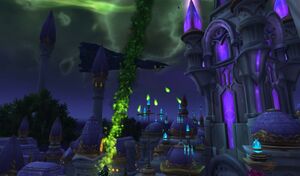
As of the third invasion of the Burning Legion, the local forces of Dalaran in the Hillsbrad Foothills were trying to reconstruct the remaining ruins of the Dalaran Crater, overseen by Archmage Cedric.[143] By the time of the start of the invasion, Dalaran City was considered neutral territory.[144]
In search of knowledge to fight the demons, Khadgar traveled to the Guardian's Library of Karazhan. There, the "spirit" of Medivh tried to convince him to become the new Guardian of Tirisfal, and showed a vision of Dalaran falling from the sky in flames, saying that if he did not accept his fate, all that Khadgar had accomplished and sacrificed would be for nothing. However, the mage replied that he would never be the Legion's pawn and destroyed the cunning nathrezim in disguise.[145]
Following the Battle for the Broken Shore, Lady Jaina Proudmoore arranged for Dalaran to move above Karazhan in Deadwind Pass in order to aid in the protection of the Eastern Kingdoms.[146][147] The entire city had been moved by a giant blink spell, and all the shops were ordered to close down because of the various troubles created by that sudden transportation. Some citizens were now suffering from dizziness and nausea, while others were re-materialized at the wrong place and were stuck in walls or in various other objects. Some of them were even fleeing because of unstable energy running amok in the city. Several recovery specialists such as Fanny Frizzlepop, Brilda and Grindle Dopplegink, as well as the nurses at the First to Your Aid clinic, were trying to fix their problems. The content of the Dalaran Merchant's Bank's coffers had been thrown out, and several Kirin Tor Guardians had to protect the bankers while they were working on fixing the situation. Jepetto Joybuzz himself was stuck on a toy zeppelin flying around the city. The entrance to the city sewers was shut and Krasus' Landing was damaged by fel energy.
Believing that the Kirin Tor needed the help of both the Alliance and the Horde, Khadgar later called the Council of Six for a vote to have the Horde return to Dalaran, in order for the Kirin Tor to fight the Legion at its utmost capability. While Jaina was vehemently opposed, especially after the events of the Broken Shore, she was outvoted with only Ansirem Runeweaver voting "no" alongside her. Feeling betrayed, Jaina lambasted the Six for blindly trusting the Horde and told them to remember her warnings the next time the Horde betrayed them again. As she left Dalaran, Khadgar became the council's replacement leader and reinstating the neutrality of Dalaran.[148] The council later voted to allow Aethas Sunreaver and his Sunreavers back into Dalaran, although not as a member of the Six.[149]
After the Burning Legion had launched an attack on the city, the Council moved the city to the southern shores of the Broken Isles in close proximity to Azsuna,[150] so it would once again serve as a hub for Azeroth's heroes at the front lines in the renewed war against the Legion when countless forces pour from the Tomb of Sargeras.
During the conflict, the Unseen Path was providing secret protection for the city at the request of Archmage Khadgar.[151] It is revealed that the tallest spire atop the Violet Citadel was actually a weapon used for the defense of the city until it was sabotaged by the Legion.[152][153] The dreadlord Kathra'natir, helpless and imprisoned within the ![]() [Nightborne Soulstone], had his power siphoned to re-power the weapon.[154] At some point, Shieldbreaker Murdonn broke through the outer defenses of Dalaran, and made it all the way to Krasus' Landing where he was defeated by the Class Orders.[155]
[Nightborne Soulstone], had his power siphoned to re-power the weapon.[154] At some point, Shieldbreaker Murdonn broke through the outer defenses of Dalaran, and made it all the way to Krasus' Landing where he was defeated by the Class Orders.[155]
At some point, Fel Lord Betrug and the aranasi Sael'orn were instructed to lead a force of demons into the city from the Violet Hold. They hired Lord Malgath to free the inmates, some being the Lich King's most powerful servants,[156] and opened fel portals for the demons' arrival. The invasion ultimately came down to nothing, as a group of adventurers defeated and repelled their attack.[111]
After the death of Kil'jaeden and Illidan's use of the Sargerite Keystone, Argus appeared in the sky of Azeroth. Dalaran's citizens grew worried, especially as doomsayers started to spread panic.
Fourth War and aftermath
During the Fourth War, Dalaran remained largely neutral and did not provide significant assistance to either side, although King Anduin Wrynn briefly attempted to reach them during the War of the Thorns.[157] At some point, emissaries of the Kirin Tor settled in both portal rooms of Stormwind City and Orgrimmar, offering access to a portal for the Broken Isles. Unlike the Pathfinder's Den, the Wizard's Sanctum was renovated and decorated with banners of the Kirin Tor, and one of their magus maintained a portal for Stormshield. Some Arcane Golems also regularly patrolled the Sanctum, similar to the ones used in Dalaran. The nation's leader, Archmage Khadgar, remained in Karazhan throughout the course of the conflict and even after its conclusion.[158]
Following the war against the Jailer, the Bronzebeard brothers visited Northrend and reported that all that remains of the Kirin Tor on the frozen continent was the contingent watching the Nexus at the Amber Ledge,[159] and that their problems with the blue dragonflight were mostly ended since the end of the Nexus War.[3]
By 40 ADP, the Kirin Tor Offensive forces were still present on the Isle of Thunder, but their once conflict with the Sunreaver Onslaught had turned into a friendly competition.[160]
Dragonflight
When the Dragon Isles emerged, Archmage Khadgar agreed to help Kalecgos and the Dragon Aspects against the Primal Incarnates. After the Kirin Tor traveled with the Dragonscale Expedition, they established Camp Antonidas and Rhonin's Shield to safeguard the wild arcane magic located across the Azure Span. Following the downfall of Fyrakk, Kalecgos regained his Aspect powers and stepped down from the Council of Six, as the dragonflights needed his full attention more than Dalaran did.[161]
People and culture
- See also: Kirin Tor#Culture
Unsurprisingly, Dalaran's national color is violet. The demonym for things originating from Dalaran is "Dalaranian".[162] The kingdom's banner is described with an intricate, knowing eye of gold on a field of violet, while below the eye, three daggers, also gold, darted earthward.[163]
The Dalaranian humans have a specific accent, as a young Khadgar mentioned to Medivh that he had to entertain a crew of Kul Tiras with it during his journey to Karazhan.[164]
Originally a human kingdom, multiple races such as the high elves, dwarves, and gnomes came over the centuries to settle, trade, or study magic in the city of Dalaran. Though traditionally barred from Dalaran, the Horde races were accepted into the city through the efforts of Archmage Aethas Sunreaver. By the time of the Scourgewar, the Kirin Tor proclaimed their kingdom neutral in the faction's conflict, while Dalaran became a neutral city where all races are welcome, so long as they behaved themselves.[3]
During one of her visits, Jaina Proudmoore described the citizens of Dalaran to be untouched and untroubled as the city itself, wandering freely in the streets. While the city-state had been the central focus of the Nexus War and the Scourgewar, one would find little here that was martial. The kingdom is at its best, and its populace happiest, when knowledge and learning are its greatest concerns.[165]
Dalaran has magic schools where young mages and schoolchildren are educated and trained in the use of magic.[166][167] As a child, Khadgar learned from most of his lessons that non-Dalaran mages, wild, untrained, and self-taught wizards without restraint, control, and thought, always ended in the same fashion with a bad end, and sometimes, though not often, destroying a large amount of the surrounding countryside with them.[168] Nonetheless, magi of the Horde are as welcome in Dalaran as those serving the Alliance.[121]
Historically, wizards have long been only men, as there was considerable resistance in Dalaran to women taking up the profession in spite of the city's tradition of training sorceresses and female archmages. No Kirin Tor-sanctioned female wizards appeared to have existed prior to 800 years ago, when Aegwynn became Guardian of Tirisfal. It has been difficult for Jaina Proudmoore to become a wizard, as she even faced considerable obstacles in her ambition to be more than a mere sorceress. Fortunately, she was able to convince Antonidas to care more for her magical talent than her gender, and she became a fully qualified wizard in record time.[169] In recent years, these restrictions are no longer present, as more women wizards were formed in the ranks of the Kirin Tor.
Since Dalaran's departure from the shores of Lordamere Lake, reagents for slow fall spells have become quite dear to any residents of Dalaran lacking wings and scales.[1]
The Dalaran Destroyers is a team sport representing Dalaran during the Battle Ball matches.
The highest honor available to non-citizens of Dalaran is the Violet Signet, a magical ring that grew in power for those who proved their loyalty to the Violet Eye, and which may become as those of the archmages of the Kirin Tor when its full power is released.[170]
Faith and folklore
Founded centuries ago in Lordaeron, the Church of the Holy Light spread its faith through the Seven Kingdoms,[171] thus the human citizens of Dalaran became followers of the Holy Light, as indicated by the Chapel Yard and the symbols of the church in the cemetery of Kirin'Var Village. In time, elven priests of Quel'Thalas came to diligently study their mysterious arts within the Halls of Magic of Dalaran.[62]
The mages of Dalaran seemingly celebrate an event called the Feast of Scribes.[172] Like the other human nations, Dalaranians are also seen celebrating other holidays such as Love is in the Air, Children's Week, Remembrance Day, Midsummer Fire Festival, Hallow's End, Day of the Dead, Winter Veil and the Volunteer Guard Day.
Notable people
Political structure
- Main articles: Magocrats, Council of Six
After the foundation of Dalaran, the Magocrat Lords of Arathor acted as the ruling archmagi of the city-state and eagerly devoted themselves to the arcane.[17] As Dalaran became the chief center of learning for magicians throughout the land, the Magocrat lords founded the Kirin Tor,[26] which eventually replaced them at the head of the nation.[19]
The Council of Six is the Kirin Tor high council of Dalaran. These six individuals are the leaders of both the city and all territories under the control of the kingdom. The Six are usually the most senior, but not necessarily the most gifted. They are chosen by several means, magic but one of them.[163] This governing body appoints one of their own as "Head of the Kirin Tor",[173] and this master wizard is essentially the ruler of Dalaran. Sometimes, the city's artisans need the approval of the Council of Six for their inventions.[174]
As a result, unlike the other human nations, Dalaran is not ruled by a traditional aristocracy and its associated class of nobles. In fact, only two known nobles are associated with the mage-state: Baron Ulrik von Stromhearth and Baroness Zildjia. It is possible, however, that their titles of nobility aren't associated with Dalaran, but with their eventual home country, like Jaina Proudmoore and Prince Kael'thas Sunstrider, who were aristocrats from other nations. Nonetheless, Dalaran deployed knights on the field during the Second War,[44] implying the presence of a gentry in the nation.
Before the First War, Dalaran was known to send ambassadors to the Stormwind City, where they were received by King Llane Wrynn I and his council.[175] They also maintained an official embassy in Lordaeron's Capital City.[176] The nation itself was noted to be a very political environment, where an honest and open man like Anduin Lothar wouldn't last more than a day and a half.[175]
When questioned for directions, the city guides remind foreigners to respect the laws of Dalaran. Like the other realms, Dalaran can apply the death penalty, and gallows are present among the ruins around the Dalaran Crater. The Kirin Tor has a very strict mentality and regulation regarding dark magics, severely punishing or eliminating those who attempt to practice them in their ranks.[56] The organization's laws also prohibited their agents from sharing Dalaran's secrets with outsiders.[177] Their magi use the Violet Hold, their main magically-shielded prison complex, to store and study powerful prisoners, preventing them from threatening the world again. As a result, the Kirin Tor has written several publications related to magic and its restrictions, notably the numerous books of The Schools of Arcane Magic written by Archmage Ansirem Runeweaver.
The Kirin Tor Guardians patrol and protect the surface of Dalaran City. The Underbelly Guard led by Guard Captain Raethan are the guardians of the Underbelly. The latter are said to be corrupt but vigilant.[178]
Notable leaders
| History | Foundation of Dalaran | Before the Dark Portal | Interlude | Interlude | ||||||||||||||||||||||||||||||||||||||||||||||||||
|---|---|---|---|---|---|---|---|---|---|---|---|---|---|---|---|---|---|---|---|---|---|---|---|---|---|---|---|---|---|---|---|---|---|---|---|---|---|---|---|---|---|---|---|---|---|---|---|---|---|---|---|---|---|---|
| Ruler | Ardogan | Grand Magus Antonidas | Unknown | Grand Magus Antonidas | Archmage Rhonin | Lady Jaina Proodmoure | Archmage Khadgar | |||||||||||||||||||||||||||||||||||||||||||||||
Factions and forces
Dalaran has been a neutral hub for the Alliance and the Horde in their wars against the Lich King and the Burning Legion.

 Kirin Tor - The ruling conclave of magi that leads the nation of Dalaran. Led by
Kirin Tor - The ruling conclave of magi that leads the nation of Dalaran. Led by  Archmage Khadgar and the Council of Six.
Archmage Khadgar and the Council of Six.
 Kirin Tor Offensive - A military contingent that led the Alliance forces in their quest for control over the Isle of Thunder.
Kirin Tor Offensive - A military contingent that led the Alliance forces in their quest for control over the Isle of Thunder.
 Tirisgarde - The elite mage-guard of Dalaran, founded by the Council of Tirisfal to replace the Guardian. Led by
Tirisgarde - The elite mage-guard of Dalaran, founded by the Council of Tirisfal to replace the Guardian. Led by  The Conjuror.
The Conjuror. Violet Eye - A secret sect keeping an eye on Karazhan, they once spied on the Guardian Medivh. Led by
Violet Eye - A secret sect keeping an eye on Karazhan, they once spied on the Guardian Medivh. Led by  Archmage Cedric.
Archmage Cedric. Underbelly Guard - The human and high elven guardians of Dalaran's Underbelly. Led by
Underbelly Guard - The human and high elven guardians of Dalaran's Underbelly. Led by  Guard Captain Raethan.
Guard Captain Raethan.
 Silver Covenant - A militant faction of high elves, they are supporters of the Alliance. Led by
Silver Covenant - A militant faction of high elves, they are supporters of the Alliance. Led by  Ranger-General Vereesa Windrunner.
Ranger-General Vereesa Windrunner.
 Sunreavers - Representatives of the kingdom of Quel'Thalas and the Horde in Dalaran. Led by
Sunreavers - Representatives of the kingdom of Quel'Thalas and the Horde in Dalaran. Led by  Archmage Aethas Sunreaver.
Archmage Aethas Sunreaver.
- Formerly
 Violet Council - An elite council of nine wizards who protected the magical vaults holding Dalaran's treasures or experiments.
Violet Council - An elite council of nine wizards who protected the magical vaults holding Dalaran's treasures or experiments. Mages' Guild - An organization that fought against the Scourge during the Siege of Dalaran. Possibly either destroyed or fused with the Kirin Tor.
Mages' Guild - An organization that fought against the Scourge during the Siege of Dalaran. Possibly either destroyed or fused with the Kirin Tor. Sorcerers' League - An organization that fought against the Scourge during the Siege of Dalaran. Possibly either destroyed or fused with the Kirin Tor.
Sorcerers' League - An organization that fought against the Scourge during the Siege of Dalaran. Possibly either destroyed or fused with the Kirin Tor.
Territories and outposts
- City of Dalaran
A large, gaping crater has replaced the old location of Dalaran, with a weakened shield in place of the opaque dome, though there is some purplish smoke around the site — possibly residue from the magic dome or the city's (literally) earth-shaking exit. It was located near the southern shores of the Lordamere Lake, north of the Hillsbrad Foothills. As of the third invasion of the Burning Legion, the local forces of Dalaran were still trying to reconstruct the remaining ruins, overseen by Archmage Cedric.[179]
The city itself currently hovers over the Broken Isles after having moved from Northrend.
Dalaran's position in Warcraft II.
Dalaran as depicted in Warcraft III.
Dalaran in Reforged.
Dalaran Crater's concept art by Peter Lee.
The dome's remains in Wrath of the Lich King.
- Settlements
The other major settlements under the magocracy's rule were Kirin'Var Village, Nethergarde Keep, and Ambermill, all of which have been lost or destroyed in recent years.
However, during their campaigns, the magocracy of Dalaran established outposts and bases of operations on different continents of Azeroth, and even beyond. In Northrend, they took up a position in the Transitus Shield, the Amber Ledge, and the Violet Stand. In Pandaria, they landed and created the Violet Rise on the Isle of Thunder. During the War in Draenor, they set up The Overlook on a plateau overlooking Mage Quarter in Stormwind City,[180] the Violet Bluff in the Everbloom, and the Khadgar's Tower in the Zangarra of Talador. During the War against the Primalists on the Dragon Isles, the Kirin Tor founded Camp Antonidas and Rhonin's Shield in Azure Span.
Dalaran in Warcraft II
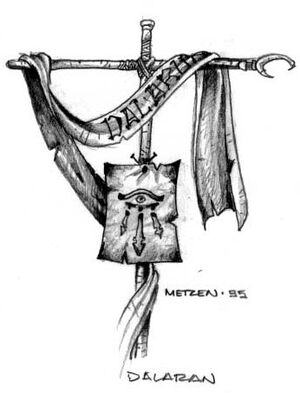
Leader: The Kirin Tor
Nation Color: Violet
Background: Dalaran is a small, magocratic nation ruled by a conclave of Wizards known as the Kirin Tor. The capital of Dalaran is the Violet Citadel at Cross Island. This nexus of supernatural forces is home to the four great towers that are sanctum to many of the land's greatest sorcerers. The Kirin Tor are strong supporters of the Alliance and to its cause have devoted the knowledge contained within their voluminous libraries as well as the power of their awesome magiks.[41]
In the RPG
Dalaran was one of the original city-states founded during the Arathorian Empire. Since its inception, the city has served as a hub of magical knowledge and experimentation in Lordaeron and the world. A multi-racial wizards' council called the Kirin Tor ruled the city for centuries, overseeing Dalaran from the Violet Citadel — a great, slender spire in the city's heart that housed the most extensive libraries and greatest laboratories in the world.
The traitor Prince Arthas Menethil laid siege to Dalaran in the Third War. He murdered its citizens, including the great archmage Antonidas, and broke into the city's heart. His ally, the lich Kel'Thuzad, then summoned Archimonde, the Burning Legion's leader. Archimonde wielded foul magic to topple the city's towers and sunder its walls. Shortly after Dalaran's fall, the undead abandoned the city to the wind and mist. Months later, a resistance force led by the surviving Dalaran wizards arrived and laid claim to the ruins. Pooling their magical power, the wizards covered Dalaran in an opaque magical sphere. It is unknown what occurs beneath the dome and the wizards warn others not to get too close.[181] The magi are certainly working on something — but none can discover what it is.[182]
Despite its hardships during the Third War, the Kirin Tor refused to abandon their home. After returning to the ruins, they destroyed those few undead creatures that remained and reclaimed their city. They erected a glowing dome around the entire city, powerful enough to destroy anyone who touches it, while they worked to rebuild their fallen city[183] long the headquarters of magical study in the world of Azeroth. The dome was impenetrable, violet, and opaque — nothing could be seen beyond it. Located on Lordamere Lake's southern shore, the original location is a low-pressure region. The environment creates mists and clouds, the air is cool and damp. A rise to the city's east marked where the demon lord Archimonde used his magic to shatter the city's spires. There were a few wrecked houses, with empty streets. Not much there.[184]
Today, the Magocracy of Dalaran continues to rule its nation, the city. Despite the destruction of its capital, Dalaran has remained an important member of the Alliance. The exact number of people living within Dalaran's protective dome is unknown, but believed to be around 3,000 or so[185] and only 120 of them are members of the Kirin Tor.[186] Mostly wizards and their conjured or created guardians inhabit Dalaran, and the city possesses few real citizens. A couple hundred troops probably dwell within and can be mustered when the call to arms is sounded. Wizards are often seen outside the dome. In particular, Archmage Ansirem Runeweaver constantly moves about the dome's periphery. The archmage seems to be in charge of Dalaran and leads a conclave of fellow wizards in their vigil of the dome. The mages hold no love for the Scourge. They would see it destroyed.[184]
The fortified outpost of Nethergarde Keep and the surrounding area in the Blasted Lands is under the control of Dalaran and Stormwind.[187]
Film universe

History
Khadgar travels to Dalaran to meet with the Kirin Tor. Initially scorned by the Kirin Tor who once trained him, the runaway Novitiate uses his research to convince Archmage Antonidas to assist him in seeking help for the Guardian's corruption. He is then led to an ancient artifact with a cube form. In response to his presence, the magical cube opens and allows the young mage inside. In the magical interior of the cube, Khadgar encounters the entity that he saw in Karazhan, Alodi, who explains that she has used the last of her power to bring him to her. She tells him that the Guardian has been corrupted and that Khadgar must defeat him, repeating the words found in the tome he stole from Karazhan: "From light comes darkness, and from darkness, light." Knowing what he must do, the young mage leaves Dalaran and returns to Stormwind to free Lothar.
Archmage Antonidas would later attend King Llane Wrynn's funeral, as a representative of Dalaran and the Kirin Tor.
Dalaran is depicted close to its World of Warcraft incarnation. It is led by Archmage Antonidas. The nation participated in the council that would eventually lead to the creation of the Alliance.
Notes
- By the time of the opening of the Great Gate, Dalaran has already become a flying city.[188] It notably contains the Chamber of Air, located within the Violet Citadel.[189]
Notes and trivia
- See also: Dalaran#Notes and trivia
- When Khadgar introduced himself to Moroes, he stated that he was from Dalaran in the kingdom of Lordaeron.[168]
- The nation's libraries record up to twenty centuries of human history, though the earliest histories are wrapped in legends.[190]
- Among the ornate spires and enchanted streets of Dalaran, the great Violet Hold stands as a testament to the glory of the city's rulers.[109]
- A group of high elf engineers helped build Dalaran's original defenses. These engineers later ended up as blood elves in Kael'thas Sunstrider's army.[191]
- Peaked Dalaran Red is a rare vintage that is not commonly asked for or served, as the price is exorbitant. High King Anduin Wrynn is known to have some in Stormwind Keep.[193]
- In an alternate universe where Aedelas Blackmoore was king of Lordaeron, the Kirin Tor was led by Antonidas, who severed all ties with Kel'Thuzad, who was Blackmoore's chief advisor. Rumor also had it that the mages liked to appear impartial but that they favored Stormwind rather than Lordaeron. Like in the main universe, Korialstrasz was a member too. His Alexstrasza understood that his work there would aid their flight and more importantly, Azeroth.[194]
- In an alternate timeline named the Warlands during the Time Rifts, what would became the Great Glorious Alliance was able to defeat the Scourge at Dalaran during the Third War.[195]
- In Beyond the Dark Portal, a Dalaran expedition was depicted as having reached the Broken Shore. They had built internment camps for the Old Horde survivors there, and had sealed the entry of the Tomb of Sargeras with two elven runestones and numerous soldiers.[196]
- Even though it was never led by a king, Dalaran is still referred to as a kingdom.[197][198][199]
- The Ultimate Visual Guides erroneously described Dalaran as "formerly ruled" by magocracy.[200] However, the Council of Six still rules it as of Legion, and it has been confirmed that Dalaran is thus still a magocracy.[2] The similarly-named Magocrat Lords, however, are long-since defunct.
- In the canceled Warcraft Adventures, a bulletin board inside Durnholde Keep indicated that the Kirin Tor was recruiting, complete with a little drawing of a mage tower.
- During the Legion announcement at gamescom 2015, it was indicated that Dalaran had some ancient purposes that weren't fully understood and that the city would be affected by proximity to the Tomb of Sargeras,[201] with the Violet Hold in particular containing newly-awakened secrets related to the origins of Dalaran, the Kirin Tor, and even the world itself.[202] However, this plotline seems to have been dropped during development.
- According to Ian Bates reporting on a discussion with Chris Metzen, some of the Cataclysm-era Silverpine Forest quests are non-canon due to a developer's error, specifically the ones dealing with Ambermill and the Forsaken-Kirin Tor conflict. The Kirin Tor at this point is supposed to be neutral.[203][204] Blizzard never officially spoke about this so it is unsure if the information is real.
- The Kirin Tor with their floating magocracy closely resemble Forgotten Realms' Netheril, one of the ancient human empires of Faerûn.
Speculation
This article or section includes speculation, observations or opinions possibly supported by lore or by Blizzard officials. It should not be taken as representing official lore.
|
- The two districts in the city occupied by foreigners, the Greyfang Enclave (former Silver Enclave) and the Windrunner's Sanctuary (former Sunreaver's Sanctuary), may have been previously occupied by the Sorcerers' League and the Mages' Guild, the other organizations that inhabited Dalaran alongside the Kirin Tor prior to the Third War.
- Like with Stromgarde Keep, the siege on Dalaran during the Second War hasn't been mentioned in any other sources besides Warcraft II, and it is thus unclear if the attack is canonical.
Gallery
Concept art of Dalaran's City Sewers.
A vision of Dalaran's fall, as shown by Medivh to Khadgar in Harbingers.
Concept art for the Warcraft film.
Shield seen on a motorbike in Heroes of the Storm.
- Fan art
Concept art of Dalaran while still in the Alterac Mountains.
See also
References
- ^ a b c World of Warcraft: The Dragonflight Codex, pg. 82
- ^ a b
 Sean Copeland 2018-03-07. Sean Copeland on Twitter. Archived from the original on 2018-03-08. Retrieved on 2018-03-08. “Confirmed! Here's an excerpt from his research: "...although the term is seldom used these days, magocracy has been used in our games and expanded universe. It is still an accurate description of Dalaran, as the nation is still ruled by magi. It's just not commonly used."”
Sean Copeland 2018-03-07. Sean Copeland on Twitter. Archived from the original on 2018-03-08. Retrieved on 2018-03-08. “Confirmed! Here's an excerpt from his research: "...although the term is seldom used these days, magocracy has been used in our games and expanded universe. It is still an accurate description of Dalaran, as the nation is still ruled by magi. It's just not commonly used."”
- ^ a b c d e Exploring Azeroth: Northrend, pg. 65: "The side they’ve taken is that of Azeroth itself [...]"
- ^
 [15-35] What Had To Be Done
[15-35] What Had To Be Done
- ^ Ultimate Visual Guide & Ultimate Visual Guide, Updated and Expanded
- ^
 [30R] All Is Well That Ends Well
[30R] All Is Well That Ends Well
- ^ a b Of Blood and Honor, chapter 5
- ^ a b c d
 [15-35] What's in the Box?
[15-35] What's in the Box?
- ^ a b c d In the Shadow of the Sun
- ^ Arthas: Rise of the Lich King, chapter 6
- ^ a b Warcraft III: Reign of Chaos manual, pg. 85
- ^ Sean Copeland on Twitter (2014-01-30) (dead link)
- ^ a b c Arthas: Rise of the Lich King, chapter 20
- ^ The Last Guardian, pg. 127
- ^ World of Warcraft: Chronicle Volume 1, pg. 134 - 135
- ^
 [15-35] The Fate of Dalaran
[15-35] The Fate of Dalaran
- ^ a b c d e The First Guardian
- ^ a b World of Warcraft: Chronicle Volume 1, pg. 135
- ^ a b
 [Mantle of the First Kirin Tor]
[Mantle of the First Kirin Tor]
- ^ "
 [The Guardians of Tirisfal]"
[The Guardians of Tirisfal]"
- ^ a b c Mage
- ^ Archive of the Tirisgarde#Ebonchill, Greatstaff of Alodi
- ^ World of Warcraft: The Dragonflight Codex, pg. 69
- ^ Libram of the Dead
- ^ World of Warcraft: Chronicle Volume 1, pg. 136
- ^ a b
 [The Seven Kingdoms]
[The Seven Kingdoms]
- ^
 [5-30] Ley Energies
[5-30] Ley Energies
- ^ World of Warcraft: Chronicle Volume 1, pg. 148
- ^

 [10-45] The Dreadlord's Prize
[10-45] The Dreadlord's Prize
- ^ World of Warcraft: Chronicle Volume 1, pg. 152 - 153
- ^ Night of the Dragon, chapter 11
- ^ World of Warcraft: Chronicle Volume 1, pg. 160
- ^ World of Warcraft: Chronicle Volume 2, pg. 105 - 106
- ^ Arthas: Rise of the Lich King, pg. 27 & 31
- ^ The Last Guardian, chapter 9
- ^ Tides of Darkness, chapter 3
- ^ World of Warcraft: Chronicle Volume 2, pg. 140
- ^ World of Warcraft: Chronicle Volume 2, pg. 142
- ^ World of Warcraft: Chronicle Volume 2, pg. 152
- ^ Tides of Darkness, chapter 5
- ^ a b Warcraft II: Tides of Darkness manual, Nations of the Alliance, Dalaran
- ^ Warcraft II: Tides of Darkness manual, Alliance Ground Units, Mage
- ^ Betrayal and the Destruction of Alterac (WC2 Human)
- ^ a b The Siege of Dalaran (WC2 Orc)
- ^ a b The Eye of Dalaran (WC2 Orc)
- ^ a b Weathered Diary - Dates from the Third War
- ^ Warcraft II: Beyond the Dark Portal manual, The Aftermath of the Second War
- ^ World of Warcraft: Chronicle Volume 2, pg. 177
- ^ World of Warcraft: Chronicle Volume 2, pg. 182
- ^ Beyond the Dark Portal, chapter 15
- ^ World of Warcraft: Chronicle Volume 2, pg. 186
- ^ Excerpts from the Journal of Archmage Vargoth
- ^ Day of the Dragon, chapter 6
- ^ Day of the Dragon, chapter 13
- ^ Day of the Dragon, chapter 21
- ^ a b Road to Damnation
- ^ The Alliance Splinters
- ^ World of Warcraft: Chronicle Volume 3, pg. 34
- ^ World of Warcraft: Chronicle Volume 3, pg. 36
- ^ Arthas: Rise of the Lich King, chapter 3
- ^ a b The Siege of Dalaran (WC3 Undead)
- ^ a b Warcraft III: Reign of Chaos Game Manual, pg. 76
- ^ The Warning
- ^ Warcraft III: Reign of Chaos manual, Undead Units, Necromancer
- ^ World of Warcraft: Chronicle Volume 3, pg. 54
- ^ World of Warcraft: Chronicle Volume 3, pg. 57
- ^ World of Warcraft: Chronicle Volume 3, pg. 64 - 65
- ^ World of Warcraft: Chronicle Volume 3, pg. 65
- ^ Under the Burning Sky
- ^ World of Warcraft: Chronicle Volume 3, pg. 66
- ^ Misconceptions (WC3 BloodElf)
- ^ The Well of Eternity, pg. 5
- ^ World of Warcraft: Chronicle Volume 3, pg. 90
- ^ The Demon Soul, chapter 11
- ^ Malfurion's Vision (WC3 NightElf)
- ^ The Ruins of Dalaran (WC3 NightElf)
- ^ World of Warcraft: Chronicle Volume 3, pg. 87
- ^ World of Warcraft: Chronicle Volume 3, pg. 91 - 92
- ^ World of Warcraft: Chronicle Volume 3, pg. 93
- ^ The Dungeons of Dalaran (WC3 BloodElf)
- ^ King Arthas (WC3 Undead)
- ^ Night of the Dragon, chapter 8
- ^ Night of the Dragon, chapter 10
- ^
 [35] Dalaran Patrols
[35] Dalaran Patrols
- ^ Jaina Proudmoore: Tides of War, pg. 272
- ^
 [Belamoore's Research Journal]
[Belamoore's Research Journal]
- ^
 [34] Prison Break In
[34] Prison Break In
- ^
 [14] Border Crossings
[14] Border Crossings
- ^
 [14] Dalaran's Intentions
[14] Dalaran's Intentions
- ^
 [16] Ambermill Investigations
[16] Ambermill Investigations
- ^



 [20] Tools of the Trade
[20] Tools of the Trade
- ^
 [42] Deliver the Shipment
[42] Deliver the Shipment
- ^
 [41] Mazen's Behest
[41] Mazen's Behest
- ^ Dalaran Agent's gossip
- ^ Curious Dalaran Relic
- ^ Custodian Dieworth#Quotes
- ^ Archmage Vargoth#Quotes
- ^
 [25-30] The Unending Invasion
[25-30] The Unending Invasion
- ^
 [25-30] Down With Daellis
[25-30] Down With Daellis
- ^
 [25-30] Capturing the Phylactery
[25-30] Capturing the Phylactery
- ^
 [25-30] Destroy Naberius!
[25-30] Destroy Naberius!
- ^
 [25-30] Curse of the Violet Tower
[25-30] Curse of the Violet Tower
- ^
 [25-30] Destroy Naberius!
[25-30] Destroy Naberius!
- ^ Night of the Dragon, chapter 2
- ^ Exploring Azeroth: Northrend, pg. 99
- ^ World of Warcraft: Chronicle Volume 3, pg. 177
- ^ Stormrage, chapter 6
- ^ Jaina Proudmoore: Tides of War, chapter 12
- ^ a b The Violet Hold (English) (HTML). Wrath Dungeons. Blizzard Entertainment Inc.. Retrieved on 2009-03-17.
- ^
 [80H] Proof of Demise: Cyanigosa
[80H] Proof of Demise: Cyanigosa
- ^ a b
 [10-45D] Assault on Violet Hold: Purple Pain
[10-45D] Assault on Violet Hold: Purple Pain
- ^ Thrall: Twilight of the Aspects, chapter 2
- ^ World of Warcraft: Chronicle Volume 3, pg. 178
- ^ World of Warcraft: The Dragonflight Codex, pg. 36
- ^ World of Warcraft: Chronicle Volume 3, pg. 182
- ^ World of Warcraft: Chronicle Volume 3, pg. 183
- ^ World of Warcraft: Chronicle Volume 3, pg. 184
- ^
 [30R] All Is Well That Ends Well
[30R] All Is Well That Ends Well
- ^ Exploring Azeroth: Northrend, pg. 68
- ^ Stormrage, chapter 24
- ^ a b Wolfheart, chapter 14
- ^
 [5-30] Breaking the Barrier
[5-30] Breaking the Barrier
- ^
 [5-30] Transdimensional Warfare: Chapter I
[5-30] Transdimensional Warfare: Chapter I
- ^
 [5-30] Transdimensional Warfare: Chapter III
[5-30] Transdimensional Warfare: Chapter III
- ^ MMO-Champion Blue Tracker - Dalaran and Cataclysm
- ^ Jaina Proudmoore: Tides of War, chapter 22
- ^ Jaina Proudmoore: Tides of War, Epilogue
- ^ Dawn of the Aspects, chapter 1
- ^
 [15-35] The Kirin Tor
[15-35] The Kirin Tor
- ^
 [15-35] The Fate of Dalaran
[15-35] The Fate of Dalaran
- ^
 [15-35] Tracking the Thieves
[15-35] Tracking the Thieves
- ^ War Crimes, chapter 31
- ^
 [15-35] Jaina's Resolution
[15-35] Jaina's Resolution
- ^
 [15-35] Nowhere to Run
[15-35] Nowhere to Run
- ^
 [15-35] Nowhere to Hide
[15-35] Nowhere to Hide
- ^ Ultimate Visual Guide, pg. 147
- ^
 [15-35] What Had To Be Done
[15-35] What Had To Be Done
- ^ Dave Kosak on Twitter (2012-12-14). “.@Leviathonlx Dalaran is in motion!”
- ^
 [10-40] Enohar's Revenge
[10-40] Enohar's Revenge
- ^ Tom Chilton at BlizzCon 2013 "...to connect this world of Draenor of 35 years in the past..."
- ^
 [20-40] Making Acquaintances
[20-40] Making Acquaintances
- ^
 [10-45] In the Blink of an Eye
[10-45] In the Blink of an Eye
- ^

 [45] Chilled to the Core
[45] Chilled to the Core
- ^ World of Warcraft: Sylvanas, chapter 24
- ^ Harbingers - Khadgar
- ^
 [10-45] The Fallen Lion
[10-45] The Fallen Lion
- ^ Dalaran over Karazhan phases in after completing the Broken Shore scenario.
- ^
 [10-45] Calling of the Council
[10-45] Calling of the Council
- ^

 [10-45] The Frozen Flame
[10-45] The Frozen Flame
- ^
 [10-45] In the Blink of an Eye
[10-45] In the Blink of an Eye
- ^
 Unseen Protection: Defending Dalaran
Unseen Protection: Defending Dalaran
- ^

 [45] An Urgent Situation
[45] An Urgent Situation
- ^

 [45] Backup Plan
[45] Backup Plan
- ^

 [45] Arming Dalaran
[45] Arming Dalaran
- ^
 Encounter at Krasus' Landing
Encounter at Krasus' Landing
- ^
 [45D] Assault on Violet Hold: Into the Violet Hold
[45D] Assault on Violet Hold: Into the Violet Hold
- ^ Elegy pgs. 36-37 - "I’ll send a unit of Stormwind guards to assist with the evacuations in Howling Oak and wherever else in Darnassus they can. Archmage Malin, get a message to Dalaran. Tell them the situation and ask if they would be willing to join us here in Stormwind—to get more refugees through portals."
- ^ World of Warcraft: Exploring Azeroth: The Eastern Kingdoms, pg. 33
- ^ World of Warcraft: Exploring Azeroth: Northrend, pg. 96
- ^ Exploring Azeroth: Pandaria pg. 94
- ^
 [70] Fair Skies and Strong Winds
[70] Fair Skies and Strong Winds
- ^ Sean Copeland on Twitter: "Lore from Chris Metzen and Micky Neilson! Alteraci (“alterackee”), Lordaeronian, Stromic, Dalaranian, Stormwindian. BOOM." March 10, 2014
- ^ a b Day of the Dragon, chapter 1
- ^ The Last Guardian, chapter 2
- ^ Jaina Proudmoore: Tides of War, chapter 20
- ^ STAY OUT!!!
- ^ The Old Wizard's Almanac
- ^ a b The Last Guardian, chapter 1
- ^ Cycle of Hatred, pg. 35
- ^ The Violet Signet questline
- ^ World of Warcraft: Chronicle Volume 2, pg. 126
- ^ The Last Guardian, pg. 177
- ^ Warcraft III: Reign of Chaos manual, Heroes and Villains, Antonidas
- ^
 [110] The Council's Approval
[110] The Council's Approval
- ^ a b The Last Guardian, chapter 4
- ^ Day of the Dragon, chapter 13
- ^
 [40] A Service to Dalaran
[40] A Service to Dalaran
- ^
 [110P] One Mage's Trash
[110P] One Mage's Trash
- ^

 [45] Chilled to the Core
[45] Chilled to the Core
- ^ Everbloom map name
- ^ Lands of Conflict, pg. 91
- ^ World of Warcraft: The Roleplaying Game, pg. 20
- ^ Alliance Player's Guide, pg. 154-155
- ^ a b Lands of Conflict, pg. 90-91
- ^ Lands of Conflict, pg. 90
- ^ Alliance Player's Guide, pg. 155
- ^ World of Warcraft: The Roleplaying Game, pg. 13
- ^ Warcraft (film)
- ^ Warcraft: The Official Movie Novelization, pg. 10
- ^ The Last Guardian, chapter 8
- ^ The Crossing (WC3 BloodElf)
- ^ The Archmage Antonidas - Part III
- ^ Before the Storm, chapter 23
- ^ Thrall: Twilight of the Aspects, chapter 10
- ^
 [Oil-Soaked Log Book]
[Oil-Soaked Log Book]
- ^ The Tomb of Sargeras (WC2x Orc)
- ^ The World of Warcraft Townhall/Classes#The Mage
- ^ Dalaran being among the Seven Kingdoms
- ^
 [10-30] The Magical Kingdom of Dalaran
[10-30] The Magical Kingdom of Dalaran
- ^ Ultimate Visual Guide, pg. 18
- ^ Odinn 2015-08-07. WoW: Legion details at gamescom: Interview with Tom Chilton & Ion Hazzikostas. Icy Veins. Retrieved on 2019-04-12.
- ^ World of Warcraft 2015-08-06. World of Warcraft Expansion Unveiling at Gamescom – Live Stream August 6 #BlizzGC2015 (54:24). YouTube. Retrieved on 2019-04-12.
- ^ Scrolls of Lore
- ^ Scrolls of Lore
| |||||||||||||||||||

